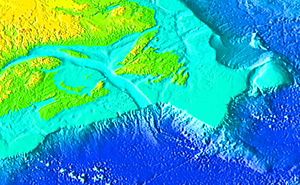Laurentian Channel facts for kids
For the underground aquifer spanning from Georgian Bay to High Park in Toronto, see Laurentian River System.
Quick facts for kids Laurentian Channel |
|
|---|---|
| Location | Gulf of Saint Lawrence |
| Coordinates | 48°30′00″N 62°00′00″W / 48.50000°N 62.00000°W |
| Type | Undersea Feature, Valley |
| Part of | Saint Lawrence River, Gulf of Saint Lawrence |
| River sources | Saint Lawrence River |
| Ocean/sea sources | Atlantic ocean |
| Basin countries | Canada |
| Max. length | 750 nautical miles (1,390 km; 860 mi) |
| Max. width | 30 nautical miles (56 km; 35 mi) |
| Surface area | 35,840 square kilometres (13,840 sq mi) |
The Laurentian Channel is a very deep underwater valley. It is located off the coast of eastern Canada. You can find it in the Gulf of Saint Lawrence.
This channel was formed by glaciers long ago. It is actually the old, sunken valley of the Saint Lawrence River. The channel stretches about 1,400 kilometres (870 mi) (870 miles). It starts near where the St. Lawrence and Saguenay Rivers meet. Then it goes past Anticosti Island and through the Gulf of St. Lawrence. Finally, it reaches the edge of the continental shelf near Newfoundland.
The channel's depth changes from 180 metres (590 ft) (590 feet) to 550 metres (1,800 ft) (1,800 feet). On each side, there are shallower areas. These "shelves" are less than 100 metres (330 ft) (330 feet) deep. The channel's width varies too. It can be as narrow as 10 kilometres (6.2 mi) (6 miles). But it widens to 55 kilometres (34 mi) (34 miles) at the Laurentian fan. This fan is at the edge of the continental shelf.
Cold, deep waters flow into the Gulf from the Atlantic Ocean. These waters move slowly up the channel. Over the last 100 years, the water at the bottom of the channel has become low in oxygen. This is called hypoxia.
Contents
Importance for Ocean Life
The Laurentian Channel is a very important place for ocean life. It provides a key home for many different marine animals. Some of these animals are caught for food. Others are not, but they are still a vital part of the ocean's natural system.
Fish and Sharks
This channel has the most black dogfish in all of Canada. It is also the only place where these sharks have their babies. Many species use the channel for spawning (laying eggs), as a nursery for young, and for feeding. These include the porbeagle shark and smooth skate.
Porbeagle sharks and basking sharks come to the area in spring. They stay there all summer. The channel is one of only two known places where porbeagle sharks mate. Two species that are at risk of disappearing, the northern wolffish and the leatherback sea turtle, have been seen here.
Whales and Dolphins
At least 20 types of whales and dolphins have been seen in this area. It is a critical feeding spot for them. It is also a major route for them to travel into and out of the Gulf of St. Lawrence.
Corals and Sea Pens
The Laurentian Channel is home to many corals and sea pens. These are sensitive habitats on the seafloor, known as benthic habitats. Corals and sea pens are very important for the ecosystem. They need the sandy and muddy seafloor to survive.
Many kinds of coral live here. Sea pens are found in the largest numbers and variety. The Laurentian Channel has the highest number of sea pens in the entire Newfoundland and Labrador Shelves Bioregion.
Laurentian Channel Marine Protected Area
In 2007, part of the Laurentian Channel was named an Ecologically and Biologically Significant Area (EBSA). This means it's a special place for nature. On June 8, 2010, the Canadian government announced it as an Area of Interest (AOI).
This AOI covers 11,619 square kilometres (4,486 sq mi) (4,486 square miles). It is located off the southwest coast of Newfoundland and Labrador. In June 2017, Fisheries and Oceans Canada (DFO) suggested making it a Marine Protected Area (MPA). This was done under the Oceans Act. In April 2019, the Laurentian Channel became an official Marine Protected Area.
The main goal of this MPA is to protect the many different kinds of life in the region. It specifically protects porbeagle sharks, smooth skates, basking sharks, black dogfish, northern wolffish, and leatherback sea turtles. It also protects sea pens and other cold-water corals.
While Atlantic cod are not officially protected, the large size of the Laurentian Channel MPA might help them. It could include a place where Atlantic cod spawn (lay eggs). Scientists are still learning about the life cycle of Atlantic cod. This makes it hard to protect them with smaller, specific protected areas. Because the Laurentian Channel MPA is so big and undivided, it has a much better chance of protecting where Atlantic cod reproduce.



